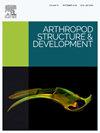An Sp6-9 ortholog is expressed in developing legs in the tardigrade Hypsibius exemplaris
IF 1.3
3区 农林科学
Q2 ENTOMOLOGY
引用次数: 0
Abstract
Orthologs of the zinc finger transcription factor-coding gene Sp6-9 are expressed in developing appendages across Arthropoda and in Onychophora. Sp6-9 regulates appendage outgrowth in some arthropods by activating Distal-less (Dll) expression. This function has been proposed to represent an ancestral function of Sp6-9 for Arthropoda. Expression patterns of Sp6-9 and Dll in the onychophoran Euperapotoides kanangrensis suggest the conservation of this function in Onychophora. Here, we investigate Sp6-9 in the tardigrade Hypsibius exemplaris. We identified two Sp6-9 orthologs in this species. One ortholog, He-Sp6-9A, was expressed in the lateral ectoderm where legs develop before He-Dll. Later, both genes were expressed in limb buds at the earliest stages of outgrowth and were broadly expressed in developing legs throughout the remainder of development. Our results present the possibility that an ortholog of Sp6-9 regulates appendage outgrowth in Tardigrada, possibly by activating or maintaining expression of He-Dll. These results raise the possibility that this function was already present in the last common ancestor of Panarthropoda.
一种Sp6-9同源基因在水熊虫样足发育中表达
锌指转录因子编码基因Sp6-9的同源物在节肢动物和爪足动物的发育附属物中表达。Sp6-9通过激活远端-less (Dll)表达调控部分节肢动物附属物生长。该功能被认为是节肢动物Sp6-9的祖先功能。Sp6-9和Dll在kanangrensis中的表达模式表明该功能在onychophoran Euperapotoides kanangrensis中保留。在这里,我们研究了缓步动物Hypsibius exemplaris体内的Sp6-9。我们在该物种中鉴定了两个Sp6-9同源物。其中一个同源物He-Sp6-9A在He-Dll之前腿发育的外侧外胚层表达。后来,这两种基因在幼体生长的最早阶段在肢体芽中表达,并在发育的其余阶段广泛表达于发育中的腿。我们的研究结果表明,Sp6-9同源物可能通过激活或维持He-Dll的表达来调节缓步动物附属物的生长。这些结果提出了这种功能在全节肢动物最后的共同祖先身上已经存在的可能性。
本文章由计算机程序翻译,如有差异,请以英文原文为准。
求助全文
约1分钟内获得全文
求助全文
来源期刊
CiteScore
3.50
自引率
10.00%
发文量
54
审稿时长
60 days
期刊介绍:
Arthropod Structure & Development is a Journal of Arthropod Structural Biology, Development, and Functional Morphology; it considers manuscripts that deal with micro- and neuroanatomy, development, biomechanics, organogenesis in particular under comparative and evolutionary aspects but not merely taxonomic papers. The aim of the journal is to publish papers in the areas of functional and comparative anatomy and development, with an emphasis on the role of cellular organization in organ function. The journal will also publish papers on organogenisis, embryonic and postembryonic development, and organ or tissue regeneration and repair. Manuscripts dealing with comparative and evolutionary aspects of microanatomy and development are encouraged.

 求助内容:
求助内容: 应助结果提醒方式:
应助结果提醒方式:


